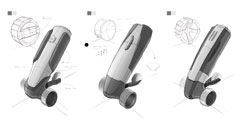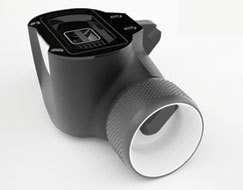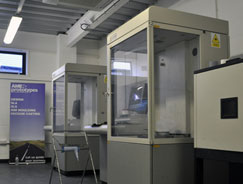Often an idea for a new product derives from personal experience. This was certainly the case for Mike Powell, an architect and keen golfer who came up with an idea for a motorised golf caddy.
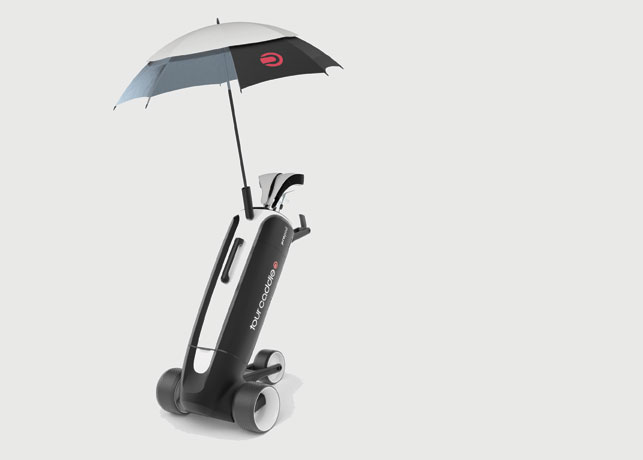
The Propod motorised golf trolley
However, unlike traditional caddies, which consist of a golf bag and a motorised trolley, his ‘Propod’ solution is a single all–in–one unit.
Having created a small clay model of his idea along with his own drawings Powell approached AME Group, an industrial design consultancy and rapid prototyping (RP) company based in Sheffield, UK. “Mike Powell had the foundations of a good golf caddy idea that is very different to what is currently on the market. It was then down to us to see whether we could turn it into a realistic concept that could be taken through to manufacture,” explains Tim Stern, design manager at AME.
Essentially, his idea was for a battery powered, pod system that consists of three elements all made of hard plastic, which can be placed separately in the boot of a car. Upon arrival at the golf course, the user just clicks all of them into place to form one unit. Firstly, the motor pod containing the battery (which can actually be charged in the car) is placed on the ground.
The carry pod is then lowered vertically on top of it and clicked into place. Lastly, the trailing arm/wheel element is locked into the back of the motor pod.
First things first
Before actually putting pencil to sketchpad, AME had to investigate how the Propod could be manufactured. “The major thing with this project was not to develop a concept with really great visuals only to discover that it’s not achievable,” says Stern.
The first part of this investigation involved looking at the specifications and cost of different parts such as the motors, rechargeable battery, gearbox and various electronic components. Powell also had a wish–list of features he wanted the final design to encompass, which AME had to incorporate.
However, instead of specifying an off–the–shelf controller, AME came up with a unique control system that involved effortless progressive steering and speed control. “In a typical single motor golf trolley, the speed is controlled by turning a dial to the desired setting and then a button is pressed to go. The user has limited directional control as it just runs in a straight line,” says Stern.
“We decided on incorporating two motors which could work independently to enable the user to steer the Propod via the controller. Basically, the user gently pushes the trolley along by the controller interface. The more force they apply, the greater the speed.”
Getting it made
The second part of the investigation involved identifying and analysing the most appropriate and cost effective methods of manufacture. “Ensuring we could achieve the high quality finishes on quite a large scale product within the required cost constraints was our biggest challenge,” admits Andy Linton, senior technical engineer at AME.
“Traditionally we would specify injection moulding to achieve high quality finishes. However, due to the potential cost of the mould tools and mouldings, this proved prohibitive. It was therefore important that we investigated alternative manufacturing techniques.”
This project was different to AME’s typical design projects in this respect as manufacturing techniques had to be researched at the start. “We could have generated a design concept that was quite leftfield but then be faced with a reality check of it being very challenging and expensive to manufacture. Or moving further down the line having to deviate significantly from the proposed concept to ensure it is feasible for manufacture. Neither of which we wanted to be faced with,” adds Linton.
Having decided to manufacture the Propod out of a tough, thermoplastic material, various moulders and toolmakers were consulted both in the UK and in China to assess the different manufacturing techniques, including structural foam injection moulding, rotational moulding and vacuum forming and the associated costs involved.
Another consideration was finding a balance between achieving high quality versus low unit costs as well as ensuring high volume production with acceptable profit margins. All these results were collated in a proposal to be presented to Powell.
Make it your own
Now it was time to develop the concept, which started with a range of sketches. The designers drew inspiration from current trends including automotive styling as they wanted to give the Propod a modern, minimalist style with clean lines.

A render showing inside the motor pod
Similar to the way in which a basic car can be customised by the user through colour and added features, the Propod comes in a variety of colours with optional extras including built–in touch screen, GPS rangefinder, wheel cleaning system, keyless locking, electronic scoreboard and an insulated drinks/food compartment.
Having refined the sketching, AME then created foam models in the workshop in order to evaluate the ergonomics, size and proportions. From there, a 3D model was created in SolidWorks with the CAD data then used to create a scaled prototype.
The full–size product will measure 900mm tall x 680mm wide but the scaled prototype was a quarter the size of this. “Generating an interactive scale model was an excellent way of visualising the final design and an effective method for Powell to demonstrate the features of the Propod at a fraction of the cost of producing a full sized product,” says Stern
The scale prototype was produced by AME’s RP division, which is located in–house below the design studio. In fact, AME’s prototyping division was founded in 1996, four years before the design division was set up because, as the client base grew, the company soon realised there was a demand for a design service too.
“We have our own client base, but there is obviously an overlap and for our clients, it’s beneficial having both design and prototyping in one place,” comments Stern.
Being a prototyping bureau in its own right, AME has a wide variety of facilities and machines including three SLA (stereo lithography) machines, a high resolution Viper SLA machine and a SLS (selective laser sintering) machine together with reactive injection moulding and vacuum casting facilities and a variety of traditional model making techniques. It serves a vast array of industries and even offers low volume manufacture, for some clients.
One stop shop
Of course, from AME’s design division’s point of view, it is extremely advantageous having a full prototyping facility available to the designers. “Having the facilities in–house we can quite quickly turn around concepts. So, literally we can send files to the machine at the end of the day and the next morning we have prototypes for testing,” says Stern.
“There is often a lag when you are using a third party so for us it really speeds up the process and our clients also like that we have this all encompassing offering. We are quite literally, a one–stop shop.”
In terms of the Propod’s prototype, standard resolution SLAs were used for the larger parts with the fine detailed parts, such as the tyre treads, produced in high resolution off the SLA Viper. With the tyres, a silicone tool was used with vacuum casting into the silicone tools to give realistic rubber properties. Traditional skills were employed to finish and paint the prototype.
“The prototype was an excellent representation of the final design. Due to its smaller scale the attention to detail was of high importance,” says Stern.
Then SolidWorks together with Maxwell Render were used to create the marketing material including a brochure in order to help Powell promote the Propod. Armed with this as well as the different solutions on how it can be manufactured, he is now actively looking for further investment and licensees to help him bring the product to market.
“This was an interesting project for AME and took advantage of all our service offerings, from developing a concept, designing for manufacture and producing a prototype,” says Stern “We hope with a great looking prototype and marketing collateral Mike can impress investors and get the product to market.”
www.ame–design.co.uk
Hole in one
Mark Vickers set up a company — I–Putt — in order to develop his own golfing product range. He initially came up with the idea for two products — the Little I golf putter training aid and Perfect Putter. He approached Stafford–based design consultancy Haughton Design to turn these ideas into reality.
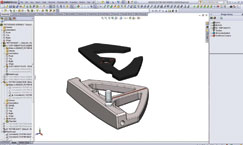
3D CAD design and development using SolidWorks
“Mark first approached us in March 2011 with the training aid project. He was looking to develop a mechanical putting device for the perfect putting stroke. He had a homemade prototype, which helped explain the idea but it needed further development.
We had to engineer it, to take out the human error and unwanted movement in the device as it was an ‘exact science’,” explains Joe Cowan, design development consultant at Haughton.
Having proved the concepts to golf’s governing body The R&A, Vickers once again called on Haughton for a third product — the Optical One Putter Head. However, this time the consultancy would be far more involved. “The first project was to validate the theory behind the product.
Once it was approved, Mark Vickers looked to develop the Optical One, which we were able to have more design input rather than just modelling up his idea.”
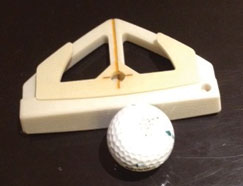
A basic prototype
The brief was to create a new mallet putter design that would encompasses the i–Spy target functionality from the Perfect Putter. This i–Spy functionality ensures the golfer has the club lined up in all planes of movement. Vickers also wanted the putter to include weights that were interchangeable by the golfer and an oversized face for ease of alignment.
Before moving into CAD, Haughton Design did some initial sketches of how it envisioned the product moving forward. SolidWorks was then utilised to create the models. “It was very difficult to fit all the different functionality into the size that Mark Vickers wanted,” says Cowan.
“Getting the weights in the correct position was challenging because it had to be balanced. I had to engineer the product to make sure that the shaft axis passed through the centre of the putter striking face to balance the weight.”
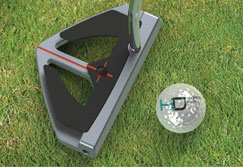
A rendering on the putting green
Haughton presented a range of solutions to Vickers to demonstrate how the design could be enhanced to make it easier to use. “We suggested laser profiling the plater for weights, which allowed us to toy with the shape and get the weight we required. This process will also have long term cost saving advantages if it moved into mass manufacture,” he says.
ARRK’s rapid prototyping services were then used to develop a basic prototype. This enabled Vickers to scrutinise the scale and size of the product.
Following detailed design, Haughton helped identify manufacturing partners and oversaw an early production run. “Working with Haughton has allowed me to transform my initial concept into a fully functioning product. I am currently raising funds as we move to the manufacturing and distribution stage,” comments Vickers.
haughtondesign.co.uk
Golfing gear from concept to manufacture
Default


